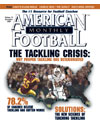AMERICAN FOOTBALL MONTHLY THE #1 RESOURCE FOR FOOTBALL COACHES
Article CategoriesAFM Magazine
|
The Sling-T Wham Seriesby: Anthony PanagakosOffensive Coordinator, Port Richmond High School (NY) © More from this issue The core of the Sling-T offense was developed using elements of the Wing-T offense and the Run ‘n Shoot offense. What we did at Port Richmond High School in New York City is expand the traditional Wing-T offense and give it more firepower. We run spread formations that give us four wide receivers at the line of scrimmage and the ability to run the traditional Wing-T ground game. In the Sling-T offense, we still run the sweep and trap series, but we can also run any of our four receiver pass patterns. The Sling-T gives an offensive coordinator more options than the traditional Wing-T and it gives the defense more problems to deal with. The defense is hard pressed to stack the line to stop the run, because of the passing threat of the spread formations (See Diagram 1). This is our base formation. As you can see, we have four receivers at th....The full article can only be seen by subscribers. Subscribe today!
|
|
|||||||
| HOME |
MAGAZINE |
SUBSCRIBE | ONLINE COLUMNISTS | COACHING VIDEOS |
Copyright 2025, AmericanFootballMonthly.com
All Rights Reserved





